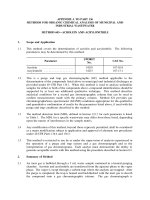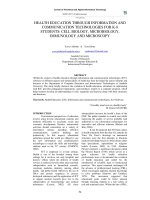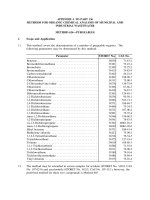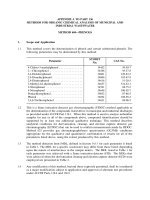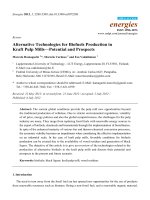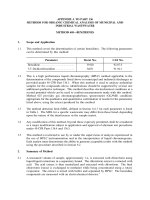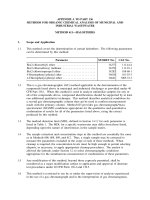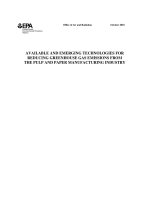Ecological technologies for industrial wastewater management petrochemicals, metals, semi conductors, and paper industries
Bạn đang xem bản rút gọn của tài liệu. Xem và tải ngay bản đầy đủ của tài liệu tại đây (10.32 MB, 299 trang )
Petrochemicals,
Metals,
Semi-Conductors,
and
Paper
Industries
Petrochemicals,
Metals,
Semi-Conductors,
and
Paper
Industries
for building
a sustainable
future.
Since
waterwater
use is
inextricably
linked
to energy
use, use,
for building
a sustainable
future.
Since
use
is inextricably
linked
to energy
90000
9 781771
881470
9 781771
881470
www.appleacademicpress.com
Tai Lieu Chat Luong
781771 881470
9 781771 9881470
Ecological Technologies for Industrial Wastewater Management
ISBN: 978-1-77188-147-0
ISBN: 978-1-77188-147-0
90000
Ecological Technologies
Industrial
Wastewater
Management
Petrochemicals,for
Metals,
Semi-Conductors,
and Paper
Industries
Petrochemicals,
Metals,
and Paper Industries
Ecological
Technologies
forSemi-Conductors,
Industrial Wastewater
Management
Ecological Technologies
for Industrial
Wastewater
Petrochemicals,
Metals, Semi-Conductors,
and Paper
Industries Management
Petrochemicals, Metals, Semi-Conductors, and Paper Industries
however,
we face
significant
challenges.
WaterWater
playsplays
an essential
role in
many,
if notif not
however,
we face
significant
challenges.
an essential
role
in many,
Water
is
essential
to
our
planet's
life,
and
protecting
our
water
resources
a prerequisite
most,
manufacturing
facilities.
In
a
world
facing
a
water-scarcity
crisis,
much
research
Water
ismost,
essential
to
our
planet's
life,
and
protecting
our
water
resources
is
a
prerequisite
manufacturing facilities. In a world facing a water-scarcity crisis, muchisresearch
for
building
a
sustainable
future.
Since
water
use
is
inextricably
linked
to
energy
development
currently
focuses
on
decreasing
industries'
water-use
footprint.
forand
building
a
sustainable
future.
Since
water
use
is
inextricably
linked
to
energy
use,
and development currently focuses on decreasing industries' water-use footprint. use,
however,
we face challenges.
significant challenges.
plays anrole
essential
role
in many, if not
however,
we
face significant
Water
playsWater
an essential
in many,
if not
This This
compendium
volume
lookslooks
briefly
at several
select
industries
and
investigates
compendium
volume
briefly
at several
select
industries
and
investigates
most,
manufacturing
facilities.
In
a
world
facing
a
water-scarcity
crisis,
much research
most,
manufacturing
facilities.
In a world
facingincluding
a water-scarcity
crisis,
much research
various
waterwater
treatment
processes
for each,
microbial
biotechnologies,
ozonevarious
treatment
processes
for each,
including
microbial
biotechnologies,
ozoneand
development
currently
focuses
on
decreasing
industries'
water-use
footprint.
andrelated
development
currently
focuses
onphotochemical
decreasing industries'
water-use
footprint.
processes,
adsorption,
and
reactions,
among
others.
The
various
related processes, adsorption, and photochemical reactions, among others. The various
This
volume
looks
brieflyselect
at several
selectand
industries
and investigates
industries
arecompendium
organized
into
four
groups:
This
compendium
volume
looks
briefly
atgroups:
several
industries
investigates
industries
are
organized
into
four
various
treatment
processes
for each,microbial
includingbiotechnologies,
microbial biotechnologies,
ozone• industries
thatwater
produce
petrochemicals
various
treatment
for
each, including
ozone•water
industries
that processes
produce
petrochemicals
related
processes,
adsorption,
and
photochemical
reactions,
among
others.
The
various
• metal
industries
related
processes,
adsorption,
and
photochemical
reactions,
among
others.
The
various
• metal industries
industries
areinto
organized
into four groups:
• the• semi-conductor
industry
industries
are
organized
four
groups:
the
semi-conductor
industry
•
industries
that
produce
petrochemicals
• the• paper
and
pulp
industries
• industries
that
produce
petrochemicals
the paper and pulp industries
•
metal
industries
• metal
industries
Collected
by a by
well-respected
expert
in theinfield,
the studies
he has
here here
are are
Collected
a well-respected
expert
the field,
the studies
he gathered
has gathered
• the semi-conductor
industry
• the
semi-conductor
industry
intended
to betoa be
starting
pointpoint
for further
investigation
by scientific
researchers
and and
intended
a
starting
for
further
investigation
by
scientific
researchers
the pulp
paperindustries
and pulp industries
• the
paper• and
graduate
students.
Today's
research,
foundfound
in these
chapters,
can be
to create
graduate
students.
Today's
research,
in these
chapters,
canexpanded
be expanded
to create
Collected
by
a
well-respected
expert
in
the
field,
the
studies
he
has
gathered
here are
tomorrow's
even
wider
frame
of
study.
Collected
by
a
well-respected
expert
in
the
field,
the
studies
he
has
gathered
here
are
tomorrow's even wider frame of study.
to bepoint
a starting
point investigation
for further investigation
scientific researchers
and
intended tointended
be a starting
for further
by scientificbyresearchers
and
graduate
students.
Today's
research,
found
in
these
chapters,
can
be
expanded
to
create
ABOUT
THE
EDITOR
graduate
students.
Today's
research,
found
in
these
chapters,
can
be
expanded
to
create
ABOUT THE EDITOR
tomorrow's
even
wider
frame of study.
tomorrow's
even
wider
frame
of
study.
Professor
Victor
Monsalvo
is anisenvironmental
scientist
with with
a PhD
in chemical
Professor
Victor
Monsalvo
an environmental
scientist
a PhD
in chemical
engineering
fromfrom
the University
Autonoma
de Madrid,
where
he later
became
a professor
engineering
the
University
Autonoma
de
Madrid,
where
he
later
became
a professor
ABOUT
THE EDITOR
ABOUT
THE
EDITOR
in thein
chemical
engineering
section.
As a As
researcher,
he has
with with
the following
the chemical
engineering
section.
a researcher,
he worked
has worked
the following
Professor
Victor
is an
scientist
with
a an
PhD
in chemical
universities:
Leeds,
Cranfield,
andenvironmental
Aachen.
He with
took
part
research
Professor
Victor
Monsalvo
isMonsalvo
an Sydney,
environmental
scientist
atook
PhDof
inanchemical
universities:
Leeds,
Cranfield,
Sydney,
and
Aachen.
He
part
ofactive
active
research
engineering
from
the
University
Autonoma
de
Madrid,
where
he
later
became
a professor
teamteam
working
in
areas
of
environmental
technologies,
water
recycling,
and
advanced
engineering
from
the
University
Autonoma
de
Madrid,
where
he
later
became
a
professor
working in areas of environmental technologies, water recycling, and advanced
in the
chemical
engineering
section.
As ainresearcher,
heresearch
has
worked
with sponsored
the following
water
treatment
systems.
He has
been
involved
sixteen
research
projects
sponsored
in the
chemical
engineering
section.
a researcher,
he
hassixteen
worked
with
theprojects
following
water
treatment
systems.
HeAs
has
been
involved
in
universities:
Leeds,
Cranfield,
Sydney,
and
Aachen.
He
took
part
of
an
active
research
by various
entities.
He
has
led
nine
research
projects
with
private
companies
and
an
universities:
Leeds,
Cranfield,
Sydney,
and
Aachen.
He
took
part
of
an
active
research
by various entities. He has led nine research projects with private companies andR&D
an R&D
team
working
in
areas
of
environmental
technologies,
water
recycling,
and
advanced
national
project,
coauthored
two
patents
(national
and
international)
and
a
book,
edited
team
working
in
areas
of
environmental
technologies,
water
recycling,
and
advanced
national project, coauthored two patents (national and international) and a book, edited
treatment
systems.
has
been
involved
in sixteen
research
projects
sponsored
twotreatment
books,
and
written
around
fifty
journal
andinrefereed
conference
papers.
He
has
water
systems.
He
has
beenHe
involved
sixteen
research
projects
sponsored
twowater
books,
and written
around
fifty
journal
and
refereed
conference
papers.
He given
has
given
by
various
entities.
He
has
led
nine
research
projects
with
private
companies
two
keynotes
in
international
conferences
and
has
been
a
member
of
the
organizing
by various
led nine research
projects
private
companies
andorganizing
an R&Dand an R&D
twoentities.
keynotesHeinhas
international
conferences
andwith
has been
a member
of the
national
coauthored
two
patents
(national
andworkshops,
international)
a book, edited
committee
of five
national
andpatents
international
conferences,
workshops,
summer
national
project,
coauthored
two
(national
and
international)
and and
a book,
edited
committee
ofproject,
five national
and international
conferences,
andand
summer
two
books,
and
written
around
fifty
journal
and
refereed
conference
papers.
He has given
He iswritten
currently
working
as senior
researcher
in theinChemical
Processes
twoschools.
books,
and
around
fifty
journal
refereed
conference
papers.
He
has given
schools.
He
is currently
working
as and
senior
researcher
the Chemical
Processes
two
keynotes
in
international
conferences
and
has
been
a
member
of
the
organizing
Abengoa
Research,
Abengoa,
Seville,
Spain.
twoDepartment
keynotes
inatinternational
conferences
and
has
been
a member
Department
at Abengoa
Research,
Abengoa,
Seville,
Spain. of the organizing
of five
and international
conferences,
and summer
committee committee
of five national
andnational
international
conferences,
workshops,workshops,
and summer
schools.
He
is
currently
working
as
senior
researcher
in
the
Chemical
Processes
schools. He is currently working as senior researcher in theISBN:
Chemical
Processes
978-1-77188-147-0
ISBN:
978-1-77188-147-0
9 0 090000 0 0
AbengoaAbengoa,
Research,Seville,
Abengoa,
Seville, Spain.
DepartmentDepartment
at AbengoaatResearch,
Spain.
Monsalvo
Monsalvo
Ecological
Technologies
for Industrial
Wastewater
Management
Ecological
Technologies
for
Wastewater
Management
WaterWater
is essential
to our
life,Industrial
and
our water
resources
is a prerequisite
is essential
toplanet's
our planet's
life, protecting
and protecting
our water
resources
is a prerequisite
Monsalvo
Monsalvo
Ecological
Technologies
for for
Industrial
Wastewater
Management
Ecological
Technologies
Industrial
Wastewater
Management
Petrochemicals,
Metals,
Semi-Conductors,
and and
Paper
Industries
Petrochemicals,
Metals,
Semi-Conductors,
Paper
Industries
Ecological
EcologicalTechnologies
Technologies
forfor
Industrial
Ecological
Technologies
Industrial
Ecological
Technologies
Wastewater
Management
for Industrial
Wastewater
Management
for
Industrial
Petrochemicals,
Metals,
Semi-Conductors,
Wastewater
Management
Petrochemicals,
Metals,
Semi-Conductors,
Wastewater
Management
andand
Paper
Industries
Paper
Industries
Petrochemicals,
Semi-Conductors,
Petrochemicals, Metals,Metals,
Semi-Conductors,
and Industries
Paper Industries
and Paper
Editor:
Victor
M. M.
Monsalvo,
PhDPhD
Editor:
Victor
Monsalvo,
Editor:M.
Victor
M. Monsalvo,
Editor: Victor
Monsalvo,
PhD PhD
ECOLOGICAL TECHNOLOGIES
FOR INDUSTRIAL
WASTEWATER MANAGEMENT
Petrochemicals, Metals,
Semi-Conductors,
and Paper Industries
ECOLOGICAL TECHNOLOGIES
FOR INDUSTRIAL
WASTEWATER MANAGEMENT
Petrochemicals, Metals,
Semi-Conductors,
and Paper Industries
Edited by
Victor M. Monsalvo, PhD
CRC Press
Taylor & Francis Group
6000 Broken Sound Parkway NW, Suite 300
Boca Raton, FL 33487-2742
Apple Academic Press, Inc
3333 Mistwell Crescent
Oakville, ON L6L 0A2
Canada
© 2016 by Apple Academic Press, Inc.
Exclusive worldwide distribution by CRC Press an imprint of Taylor & Francis Group, an Informa
business
No claim to original U.S. Government works
Version Date: 20150602
International Standard Book Number-13: 978-1-77188-286-6 (eBook - PDF)
This book contains information obtained from authentic and highly regarded sources. Reasonable efforts have been made to publish reliable data and information, but the author and publisher
cannot assume responsibility for the validity of all materials or the consequences of their use. The
authors and publishers have attempted to trace the copyright holders of all material reproduced in
this publication and apologize to copyright holders if permission to publish in this form has not
been obtained. If any copyright material has not been acknowledged please write and let us know so
we may rectify in any future reprint.
Except as permitted under U.S. Copyright Law, no part of this book may be reprinted, reproduced,
transmitted, or utilized in any form by any electronic, mechanical, or other means, now known or
hereafter invented, including photocopying, microfilming, and recording, or in any information
storage or retrieval system, without written permission from the publishers.
For permission to photocopy or use material electronically from this work, please access www.
copyright.com ( or contact the Copyright Clearance Center, Inc.
(CCC), 222 Rosewood Drive, Danvers, MA 01923, 978-750-8400. CCC is a not-for-profit organization that provides licenses and registration for a variety of users. For organizations that have been
granted a photocopy license by the CCC, a separate system of payment has been arranged.
Trademark Notice: Product or corporate names may be trademarks or registered trademarks, and
are used only for identification and explanation without intent to infringe.
Visit the Taylor & Francis Web site at
and the CRC Press Web site at
For information about Apple Academic Press product
ABOUT THE EDITOR
VICTOR M. MONSALVO
Professor Victor Monsalvo is an environmental scientist with a PhD in
chemical engineering from the University Autonoma de Madrid, where
he later became a professor in the chemical engineering section. As a researcher, he has worked with the following universities: Leeds, Cranfield,
Sydney, and Aachen. He took part of an active research team working
in areas of environmental technologies, water recycling, and advanced
water treatment systems. He has been involved in sixteen research projects sponsored by various entities. He has led nine research projects with
private companies and an R&D national project, coauthored two patents
(national and international) and a book, edited two books, and written
around fifty journal and referred conference papers. He has given two key
notes in international conferences and has been a member of the organizing committee of five national and international conferences, workshops,
and summer schools. He is currently working as senior researcher in the
Chemical Processes Department at Abengoa Research, Abengoa.
CONTENTS
Acknowledgment and How to Cite ................................................................................ ixx
List of Contributors ......................................................................................................... xi
Introduction .................................................................................................................... xv
Part I: Industrial Petrochemicals
1.
Anaerobic Treatment of Wastewater from Used Industrial
Oil Recovery ................................................................................................ 3
Nuria Garcia-Mancha, Daniel Puyol, Victor M. Monsalvo, Hayfa Rajhi,
Angel F. Mohedano and Juan J. Rodriguez
2.
LDHs as Adsorbents of Phenol and Their Environmental Applications ... 27
E. Butenko, A. Malyshev, and A. Kapustin
3.
Biodegradability of Oily Wastewater Using Rotating Biological
Contactor Combined with an External Membrane............................... 41
Mahdieh Safa, Iran Alemzadeh, and Manouchehr Vossoughi
Part II: Metal Industries
4.
Removal of Vanadium(III) and Molybdenum(V) from Wastewater
Using Posidonia oceanica (Tracheophyta) Biomass............................... 55
Chiara Pennesi, Cecilia Totti, Francesca Beolchini
5.
The Effective Electrolytic Recovery of Dilute Copper from
Industrial Wastewater .............................................................................. 87
Teng-Chien Chen, Ricky Priambodo, Ruo-Lin Huang, and Yao-Hui Huang
6.
Intracellular Biosynthesis and Removal of Copper Nanoparticles
by Dead Biomass of Yeast Isolated from the Wastewater of a Mine
in the Brazilian Amazonia...................................................................... 105
Marcia R. Salvadori, Rômulo A. Ando, Cláudio A. Oller do Nascimento,
and Benedito Corrêa
Part III: Semi-Conductor Industry
7.
Application of Ozone Related Processes to Mineralize Tetramethyl
Ammonium Hydroxide in Aqueous Solution ....................................... 133
Chyow-San Chiou, Kai-Jen Chuang, Ya-Fen Lin, Hua-Wei Chen, and Chih-Ming Ma
viii
8.
Contents
Physico-chemical Investigation of Semiconductor
Industrial Wastewater ........................................................................... 153
Y. C.Wong, V. Moganaragi, and N. A. Atiqah
9.
Improving the Efficiency of a Coagulation-Flocculation Wastewater
Treatment of the Semiconductor Industry through Zeta
Potential Measurements ......................................................................... 167
Eduardo Alberto López-Maldonado, Mercedes Teresita Oropeza-Guzmán,
and Adrián Ochoa-Terán
Part IV: Pulp and Paper Industries
10. Improvement of Biodegradability Index Through
Electrocoagulation and Advanced Oxidation Process ......................... 199
A. Asha, Keerthi, A. Muthukrishnaraj, and N. Balasubramanian
11. Removal of Lignin from Wastewater through Electro-Coagulation .... 217
Ravi Shankar, Lovjeet Singh, Prasenjit Mondal, and Shri Chand
12. Treatment of Wastewater Effluents from Paper-Recycling Plants
by Coagulation Process and Optimization of Treatment Conditions
with Response Surface Methodology .................................................... 233
Noushin Birjandi, Habibollah Younesi, and Nader Bahramifar
Part V: Conclusion
13. Life Cycle Assessment Applications in Wastewater Treatment .......... 263
Nurdan Buyukkamaci
Author Notes.................................................................................................... 269
Index ................................................................................................................. 273
ACKNOWLEDGMENT AND
HOW TO CITE
The editor and publisher thank each of the authors who contributed to this
book. The chapters in this book were previously published elsewhere. To
cite the work contained in this book and to view the individual permissions,
please refer to the citation at the beginning of each chapter. Each chapter
was read individually and carefully selected by the editor; the result is a
book that provides a comprehensive perspective on industrial wastewater
management. The chapters included examine the following topics:
• Chapter 1 assesses the anaerobic biological treatment of wastewater resulting from the regeneration process of used industrial oil by determining the
optimal operating conditions of an expanded granular sludge bed reactor.
• Chapter 2 outlines the authors’ search for new anionic sorbents, the use of
which would allow more effective removal of phenols from wastewater.
• Oily wastewater is a major environmental problem, which conventional
water treatments are insufficient to address. Chapter 3 compares the performance of two viable treatment methods: a rotating biological contactor and
a hybrid membrane reactor.
• Heavy metals released into the environment via wastewater from steel
industries are persistent environmental contaminants that accumulate
throughout the food chain with serious ecological and human-health effects. Chapter 4 explores the potential of marine biomass to offer a cheap
and efficient elimination technology.
• Chapter 5 investigates the optimal conditions, including effects of iron
concentration and electric current, for electrolytic recovery of copper from
electroplating wastewater.
• Chapter 6 explores the potential of the yeast Rhodotorula mucilaginosa to
remove and convert copper ions to copper nanoparticles, a cheap and effective wastewater treatment method.
• The production of semiconductors often uses TMAH (tetramethyl ammonium hydroxide), which is then released into the environment via wastewater. The authors of chapter 7 assess the function of UV light, a magnetic
catalyst, and hydrogen peroxide on enhancing ozone in order to mineralize
TMAH.
• Chapter 8 identifies the characteristics of semiconductor wastewater before
and after treatment, the quality that must be maintained in the environment
x
Acknowledgment and how to Cite
•
•
•
•
•
to which the wastewater is to be discharged or reused, and methods for
analyzing various physical and chemical parameters.
Electroplating is one of the important steps in the production of semiconductors, producing wastewater with high concentration of suspended solids, organic compounds, and dissolved cation. The authors of chapter 9 investigate more efficient polyelectrolytes treatment with low environmental
impact.
In Chapter 10, the authors study ways to improve the biodegradability index of wastewater from pulp and paper industries, using electrocoagulation
and different advanced oxidation processes.
The lignin released into wastewater by paper and pulp industries cannot be
easily removed by traditional biochemical treatments. In chapter 11, the authors offer further research into the electrocoagulation technique for paper
and pulp wastewater treatment.
Different types of paper mills produce different types of effluent, requiring
different treatments. The authors of chapter 12 investigate the interactive
factors that effect paper mill wastewater in order to optimize the coagulation process.
The LCA approach, described in chapter 13, is useful for designing and
constructing the most efficient wastewater treatment plants with the least
environmental impact.
LIST OF CONTRIBUTORS
Iran Alemzadeh
Chemical and petroleum engineering department, Sharif University of Technology, Azadi St, Tehran,
Iran
Rơmulo A. Ando
Departamento de Qmica Fundamental, Instituto de Química, Universidade de São Paulo, São Paulo,
São Paulo, Brazil
A. Asha
Department of Chemical Engineering, A.C. Tech. Campus Anna University, Chennai, 600 025, India
N. A. Atiqah
Faculty of Agro Based Industry, Universiti Malaysia Kelantan,Jeli Campus, Locked Bag 100, 17600
Jeli, Kelantan, Malaysia
Nader Bahramifar
Department of Environmental Science, Faculty of Natural Resources, Tarbiat Modares University,
P.O. Box 46414-356, Noor, Iran
N. Balasubramanian
Department of Chemical Engineering, A.C. Tech. Campus Anna University, Chennai, 600 025, India
Francesca Beolchini
Department of Life and Environmental Sciences, Polytechnic University of Marche, Ancona, Italy
Noushin Birjandi
Department of Environmental Science, Faculty of Natural Resources, Tarbiat Modares University,
P.O. Box 46414-356, Noor, Iran
Butenko E.
Azov Sea State Technical University, Mariupol, Ukraine
Nurdan Buyukkamaci
Dokuz Eylul University, Engineering Faculty, Department of Environmental Engineering, Tinaztepe
Campus, Buca, Izmir, Turkey
xii
List of Contributors
Shri Chand
Department of Chemical Engineering, Indian Institute of Technology Roorkee, Uttarakhand, India
Hua-Wei Chen
Department of Cosmetic Application & Management, St. Mary’s Junior College of Medicine, Nursing
and Management, Yilan 266, Taiwan
Teng-Chien Chen
Department of Chemical Engineering, National Cheng Kung University, Tainan 701, Taiwan; Sustainable Environment Research Center, National Cheng Kung University, Tainan 701, Taiwan
Chyow-San Chiou
Department of Environmental Engineering, National Ilan University, Ilan 260, Taiwan
Kai-Jen Chuang
Department of Public Health, School of Medicine, College of Medicine, Taipei Medical University,
Taipei 110, Taiwan; School of Public Health, College of Public Health and Nutrition, Taipei Medical
University, Taipei 110, Taiwan
Benedito Corrêa
Departamento de Microbiologia, Instituto de Ciências Biomédicas II, Universidade de São Paulo, São
Paulo, São Paulo, Brazil
Nuria Garcia-Mancha
Sección Departamental de Ingenieria Quimica, Universidad Autonoma de Madrid, Francisco Tomas y
Valiente 7, Madrid, 28049, Spain
Ruo-Lin Huang
Department of Chemical Engineering, National Cheng Kung University, Tainan 701, Taiwan
Yao-Hui Huang
Department of Chemical Engineering, National Cheng Kung University, Tainan 701, Taiwan; Sustainable Environment Research Center, National Cheng Kung University, Tainan 701, Taiwan
A. Kapustin
Azov Sea State Technical University, Mariupol, Ukraine
Ya-Fen Lin
Department of Environmental Engineering, National Ilan University, Ilan 260, Taiwan
List of Contributors
xiii
Eduardo Alberto López-Maldonado
Centro de Investigación y Desarrollo Tecnológico en Electroquímica (CIDETEQ), Carretera Libre
Tijuana-Tecate km. 26.5, Parque Industrial El Florido, 22500 Tijuana, BC, Mexico
Chih-Ming Ma
Department of Cosmetic Application & Management, St. Mary’s Junior College of Medicine, Nursing
and Management, Yilan 266, Taiwan
A. Malyshev
SASOL Germany GmbH
V. Moganaragi
Faculty of Agro Based Industry, Universiti Malaysia Kelantan,Jeli Campus, Locked Bag 100, 17600
Jeli, Kelantan, Malaysia
Angel F. Mohedano
Sección Departamental de Ingenieria Quimica, Universidad Autonoma de Madrid, Francisco Tomas y
Valiente 7, Madrid, 28049, Spain
Prasenjit Mondal
Department of Chemical Engineering, Indian Institute of Technology Roorkee, Uttarakhand, India
Victor M. Monsalvo
Sección Departamental de Ingenieria Quimica, Universidad Autonoma de Madrid, Francisco Tomas y
Valiente 7, Madrid, 28049, Spain
A. Muthukrishnaraj
Department of Chemical Engineering, A.C. Tech. Campus Anna University, Chennai, 600 025, India
Cláudio A. Oller do Nascimento
Departamento de Engenharia Química, Politécnica, Universidade de São Paulo, São Paulo, São Paulo,
Brazil
Adrián Ochoa-Terán
Centro de Graduados e Investigación en Qmica del Instituto Tecnológico de Tijuana, Boulevard
Alberto Limón Padilla s/n, Mesa de Otay, 22500 Tijuana, BC, Mexico
Mercedes Teresita Oropeza-Guzmán
Centro de Investigación y Desarrollo Tecnológico en Electroqmica (CIDETEQ), Carretera Libre
Tijuana-Tecate km. 26.5, Parque Industrial El Florido, 22500 Tijuana, BC, Mexico; Centro de Graduados e Investigación en Qmica del Instituto Tecnológico de Tijuana, Boulevard Alberto Limón Padilla
s/n, Mesa de Otay, 22500 Tijuana, BC, Mexico
xiv
List of Contributors
Chiara Pennesi
Department of Life and Environmental Sciences, Polytechnic University of Marche, Ancona, Italy
Ricky Priambodo
Department of Chemical Engineering, National Cheng Kung University, Tainan 701, Taiwan
Daniel Puyol
Sección Departamental de Ingenieria Quimica, Universidad Autonoma de Madrid, Francisco Tomas y
Valiente 7, Madrid, 28049, Spain
Hayfa Rajhi
Departamento de Biologia Molecular, Universidad Autonoma de Madrid, Darwin 2, Madrid, 28049,
Spain
Juan J. Rodriguez
Sección Departamental de Ingenieria Quimica, Universidad Autonoma de Madrid, Francisco Tomas y
Valiente 7, Madrid, 28049, Spain
Mahdieh Safa
Chemical and petroleum engineering department, Sharif University of Technology, Azadi St, Tehran,
Iran
Marcia R. Salvadori
Departamento de Microbiologia, Instituto de Ciências Biomédicas II, Universidade de São Paulo, São
Paulo, São Paulo, Brazil
Ravi Shankar
Department of Chemical Engineering, Indian Institute of Technology Roorkee, Uttarakhand, India
Lovjeet Singh
Department of Chemical Engineering, Indian Institute of Technology Roorkee, Uttarakhand, India
Keerthi Srinivas
Department of Chemical Engineering, A.C. Tech. Campus Anna University, Chennai, 600 025, India
Cecilia Totti
Department of Life and Environmental Sciences, Polytechnic University of Marche, Ancona, Italy
Manouchehr Vossoughi
Chemical and petroleum engineering department, Sharif University of Technology, Azadi St, Tehran,
Iran
List of Contributors
xv
Y. C. Wong
Faculty of Agro Based Industry, Universiti Malaysia Kelantan,Jeli Campus, Locked Bag 100, 17600
Jeli, Kelantan, Malaysia
Habibollah Younesi
Department of Environmental Science, Faculty of Natural Resources, Tarbiat Modares University,
P.O. Box 46414-356, Noor, Iran
INTRODUCTION
Water is essential to our planet’s life. Protecting our water resources is
a prerequisite for building a sustainable future. But we face significant
challenges.
Water use is inextricably linked to energy use. Water plays an essential role in many, if not most, manufacturing facilities, since most industries are dependent on processes that ultimately produce wastewaters. In
a world facing a water-scarcity crisis, much research and development is
focusing on decreasing industries’ water-use footprint.
This compendium volume looks briefly at several select industries—
industries that produce petrochemicals, metal industries, the semiconductor industry, and paper and pulp industries—and investigates
various water treatment processes for each. These include microbial biotechnologies, ozone-related processes, adsorption, and photochemical
reactions, among others.
Obviously, this is by no means an exhaustive or comprehensive coverage of the topic; the scope of this compendium is not great enough
to investigate all treatment methods across a wider range of industries.
Instead, the research gathered here is intended to be a starting point for
further investigation. It also offers specific directions to follow further,
expanding the potential of these particular studies into a wider frame of
research work.
—Victor M. Monsalvo
In chapter 1, the authors focus on the anaerobic biodegradation of wastewater from used industrial oils (UIO) recovery using a bench-scale
expanded granular sludge bed reactor (EGSB) at room temperature.
Biodegradability tests showed that this wastewater can be partially biodegraded under anaerobic conditions at mesophilic temperature. Low
concentrations of wastewater caused an incremented specific activity
xviii
Introduction
of the acetoclastic and the hydrogenotrophic methanogens. Anaerobic
biodegradation at room temperature is feasible at organic loading rates
(OLR) lower than 5.5 g COD L−1 d−1. A further increase of the OLR to
around 10 g COD L−1 d−1 had a detrimental effect on the system performance, making it necessary to work at mesophilic conditions. The
authors conclude that anaerobic treatment using an EGSB reactor is a
feasible option for treating UIO wastewater. Long-term treatment caused
a specialization of the granular sludge, modifying substantially its microbial composition. Methane production was even stimulated by the
addition of UIO wastewater at low concentrations.
Next, in chapter 2, the authors develop a method of synthesis of layered
double hydroxides (LDH) of different composition. They investigate the
processes of adsorption of phenols on LDH variable composition. Finally,
they design kinetic parameters for the processes of phenol adsorption.
Chapter 3 studies a novel implementation of a hybrid membrane bioreactor (HMBR), utilized as combination of rotating biological contractor
(RBC) and an external membrane, as a new biological system for oily
wastewater treatment. The authors evaluate chemical oxygen demand
(COD) and total petroleum hydrocarbon (TPH) as factors of biodegradability. Both factors are compared with each other for different hydraulic
retention times (HRTs) and petroleum pollution concentrations in RBC
and HMBR. The ratio of TPH to COD of molasses was varied between
0.2 to 0.8 at two HRTs of 18 and 24 hours, while the temperature, pH, and
dissolved oxygen were kept in the range of 20–25°C, 6.5–7.5, and 2–3.5
mg/l, respectively. The best TPH removal efficiency (99%) was observed
in TPH/COD = 0.6 and HRT = 24 hr in HMBR, and removal efficiency
was decreased in the ratios above 0.6 in both bioreactors. The experimental results showed that HMBR had higher treatment efficiency than RBC
at all ratios and HRTs.
The use of dried and re-hydrated biomass of the seagrass Posidonia
oceanica was investigated in chapter 4 as an alternative and low-cost biomaterial for removal of vanadium(III) and molybdenum(V) from wastewaters. Initial characterization of this biomaterial identified carboxylic
groups on the cuticle as potentially responsible for cation sorption, and
confirmed the toxic-metal bioaccumulation. The combined effects on biosorption performance of equilibrium pH and metal concentrations were
Introduction
xix
studied in an ideal single-metal system and in more real-life multicomponent systems. There were either with one metal (vanadium or molybdenum) and sodium nitrate, as representative of high ionic strength systems,
or with the two metals (vanadium and molybdenum). For the single-metal
solutions, the optimum was at pH 3, where a significant proportion of vanadium was removed (ca. 70%) while there was ca. 40% adsorption of
molybdenum. The data obtained from the more real-life multicomponent
systems showed that biosorption of one metal was improved both by the
presence of the other metal and by high ionic strength, suggesting a synergistic effect on biosorption rather than competition. The authors then
used the data to develop a simple multi-metal equilibrium model based on
the noncompetitive Langmuir approach, which was successfully fitted to
experimental data and represents a useful support tool for the prediction of
biosorption performance in such real-life systems. Overall, the results suggest that biomass of P. oceanica can be used as an efficient biosorbent for
removal of vanadium(III) and molybdenum(V) from aqueous solutions.
This process thus offers an eco-compatible solution for the reuse of the
waste material of leaves that accumulate on the beach due to both human
activities and to storms at sea.
The electroplating copper industry in Taiwan discharges huge amounts
of wastewater, causing serious environmental and health damage. Chapter
5 applies to this situation research into the electrical copper recovery system. The authors study the electrotreatment of an industrial copper wastewater ([Cu] = 30000 mg L−1) with titanium net coated with a thin layer of
RuO2/IrO2 (DSA) reactor. The optimal result for simulated copper solution was 99.9% copper recovery efficiency in current density 0.585 A/dm2
and no iron ion. Due to high concentrations of iron and chloride ions in real
industrial wastewater, the copper recovery efficiency went down to 60%.
Although, the copper recovery efficiency was not as high as in the simulated copper solution, high environmental economic value was included in
the technology. The authors conclude that pretreating the wastewater with
iron is a necessary step, before the electrical recovery copper system.
In the study described in chapter 6, a natural process was developed
using a biological system for the biosynthesis of nanoparticles (NPs)
and the yeast Rhodotorula mucilaginosa for the removal of copper from
wastewater by dead biomass. Dead and live biomass of Rhodotorula
xx
Introduction
mucilaginosa was used to analyze the equilibrium and kinetics of copper
biosorption by the yeast in function of the initial metal concentration,
contact time, pH, temperature, agitation, and inoculum volume. Dead
biomass exhibited the highest biosorption capacity of copper, 26.2 mg
g−1, which was achieved within 60 min of contact, at pH 5.0, temperature
of 30°C, and agitation speed of 150 rpm. The equilibrium data were best
described by the Langmuir isotherm, and kinetic analysis indicated a
pseudo-second-order model. The authors determined the average size,
morphology, and location of NPs biosynthesized by the yeast by scanning electron microscopy (SEM), energy dispersive X-ray spectroscopy
(EDS), and transmission electron microscopy (TEM). The shape of the
intracellularly synthesized NPs was mainly spherical, with an average
size of 10.5 nm. The X-ray photoelectron spectroscopy (XPS) analysis
of the copper NPs confirmed the formation of metallic copper. The authors conclude that the dead biomass of Rhodotorula mucilaginosa may
be considered an efficient bioprocess, being fast and low-cost. It is also
probably nano-adsorbent for the production of copper nanoparticles in
wastewater in the bioremediation process.
Tetramethyl ammonium hydroxide (TMAH) is an anisotropic etchant
used in the wet etching process of the semiconductor industry and is hard
to degrade by biotreatments when it exists in wastewater. The study in
chapter 7 evaluated the performance of a system combined with ultraviolet, magnetic catalyst (SiO2/Fe3O4) and O3, denoted as UV/O3, to TMAH in
an aqueous solution. The mineralization efficiency of TMAH under various conditions follows the sequence: UV/O3 > UV/H2O2/O3 > H2O2/SiO2/
Fe3O4/O3 > H2O2/O3 > SiO2/Fe3O4/O3 > O3 > UV/H2O2. The results suggest
that UV/O3 process provides the best condition for the mineralization of
TMAH (40 mg/L), resulting in 87.6% mineralization, at 60 min reaction
time. Furthermore, the mineralization efficiency of SiO2/Fe3O4/H2O2/O3
was significantly higher than that of O3, H2O2/O3, and UV/H2O2. More
than 90% of the magnetic catalyst was recovered and easily redispersed in
a solution for reuse.
In the study described in chapter 8, the treated and untreated effluents samples from semiconductor industry were collected and their physical characteristics (such as temperature, pH, turbidity, total suspended
solid (TSS), conductivity) and chemical characteristics (such as salinity,
Introduction
xxi
dissolved oxygen (DO), biological oxygen demand (BOD), chemical oxygen demand (COD), chlorine dioxide, and heavy metal) were analyzed.
The results showed that the semiconductor industry fulfilled the standard
of law that was established in order to protect the environment.
The authors of chapter 9 improved the efficiency of coagulation-flocculation process used for semiconductor wastewater treatment by selecting
suitable conditions (pH, polyelectrolyte type, and concentration) through
zeta potential measurements. Under this scenario, the zeta potential, ζ, is
the right parameter that allows studying and predicting the interactions at
the molecular level between the contaminants in the wastewater and polyelectrolytes used for coagulation-flocculation. Additionally, this parameter
is a key factor for assessing the efficiency of coagulation-flocculation processes based on the optimum dosages and windows for polyelectrolytes
coagulation-flocculation effectiveness. In this chapter, strategic pH variations allowed the prediction of the dosage of polyelectrolyte on wastewater from real electroplating baths, including the isoelectric point (IEP) of
the dispersions of water and commercial polyelectrolytes used in typical
semiconductor industries. The results showed that there is a difference
between polyelectrolyte demand required for the removal of suspended
solids, turbidity, and organic matter from wastewater (23.4 mg/L and
67 mg/L, resp.). The authors also conclude that the dose of polyelectrolytes and coagulation-flocculation window to achieve compliance with
national and international regulations (the EPA in United States and
SEMARNAT in Mexico) is influenced by the physicochemical characteristics of the dispersions and treatment conditions (pH and polyelectrolyte
dosing strategy).
In recent years, extensive work has been conducted to improve the biodegradability index (BI) of effluent to enhance the efficiency of biochemical treatment. Advanced oxidation processes are one among the various
methods primer to improve the BI of organic effluent. In the investigation
described in chapter 10, experiments such as electrocoagulation, electrooxidation, and photochemical processes were carried out to treat pulp and
paper wastewater in a wide range of operating conditions. The effect of
individual parameters on BI improvement was critically examined. The
authors noticed that electro-oxidation method yields maximum biodegradability improvement (0.13–0.42) within a process time of 35 minutes.
xxii
Introduction
Chapter 11 deals with the removal of lignin (expressed as COD removal) from synthetic wastewater through electrocoagulation in a batch
reactor, using aluminum as a sacrificial electrode. The authors investigate the effects of various parameters such as current density, pH, NaCl
concentration, and treatment time on the removal of COD from synthetic
wastewater to determine the most suitable process conditions for maximum removal of COD (lignin). They use a central composite design
(CCD) to create the experimental conditions for developing mathematical
models to correlate the removal efficiency with the process variables. The
most suitable conditions for the removal of lignin from synthetic solution
were found to be: a current density of 100A/m2; a pH of 7.6; NaCl concentrations of 0.75mg/l; and a treatment time of 75 minutes. The authors’
proposed model gives prediction on COD (lignin) removal with the error
limit around +9 to –7%
In chapter 12, a coagulation process was used to treat paper-recycling
wastewater with alum, coupled with poly aluminum chloride (PACl) as
coagulants. The authors investigated the effect of each four factors, viz.
the dosages of alum and PACl, pH and chemical oxygen demand (COD),
on the treatment efficiency. They describe the influence of these four parameters using response-surface methodology under central composite
design, and they consider the efficiency of reducing turbidity, COD and
the sludge volume index (SVI) as the responses. The optimum conditions
for high treatment efficiency of paper-recycling wastewater under experimental conditions were reached with numerical optimization of coagulant
doses and pH, with 1,550 mg/l alum and 1,314 mg/l PACl and 9.5, respectively, where the values for reduction of 80.02% in COD, 83.23% in
turbidity, and 140 ml/g in SVI were obtained.
In the final chapter, the author uses the Life Cycle Assessment (LCA),
a “cradle-to-grave” approach, to identify energy use, material input, and
waste generated, starting with the acquisition of raw materials and ending
with the final disposal of a product from a particular facility. His review
consists of four main activities: goal and scope, inventory analysis, impact assessment, and interpretation. In order to design and construct the
most appropriate wastewater treatment plants, he points to the LCA approach as a useful tool for evaluating wastewater treatment techniques.
He concludes that further, more detailed investigation is called for into the
Introduction
xxiii
benefits and harms of each application in order to determine alternative,
more environmentally friendly treatment methods using techniques that
consume the least amount of energy.

